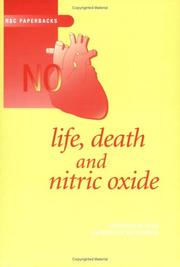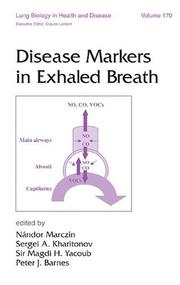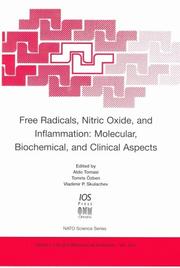| Listing 1 - 4 of 4 |
Sort by
|

ISBN: 1847551238 9781847551238 0854046860 9780854046867 Year: 2003 Publisher: Cambridge Royal Society of Chemistry
Abstract | Keywords | Export | Availability | Bookmark
 Loading...
Loading...Choose an application
- Reference Manager
- EndNote
- RefWorks (Direct export to RefWorks)
Designated 'Molecule of the Year' in 1992 in recognition of its many biological roles, nitric oxide has wide significance in the world around us and the story of nitric oxide is still unfolding. This small and seemingly innocent molecule has for many years been known to play a significant role in both the creation of photochemical smogs and in the nitrogen cycle. It has an interesting chemistry as a metal ligand, and the bonding within the nitric oxide molecule has been extensively studied. More recently, the molecule has been in the spotlight for the role it plays in controlling blood flow, i
Nitric oxide. --- Nitric oxide --- Endothelial relaxing factor --- Endothelium-derived relaxing factors --- Nitrogen oxide --- Neurotransmitters --- Nitrogen compounds --- Oxides --- Pathophysiology. --- Physiological effect. --- 546.172.6 --- Pathophysiology --- Physiological effect --- 546.172.6 Nitric oxide NO and its derivatives --- Nitric oxide NO and its derivatives

ISBN: 0824708172 Year: 2003 Publisher: New York Dekker
Abstract | Keywords | Export | Availability | Bookmark
 Loading...
Loading...Choose an application
- Reference Manager
- EndNote
- RefWorks (Direct export to RefWorks)
Pathology of the respiratory system --- Pathological physiology. Pathogenesis --- Biochemical markers. --- Breath tests. --- Carbon monoxide --- Lungs --- Nitric oxide --- Biological Markers --- Lung Diseases. --- Nitric Oxide --- Respiration. --- Pathophysiology. --- Diseases --- Diagnosis. --- analysis. --- Biological markers --- Breath tests --- Respiration

ISBN: 1586032437 0585458731 9780585458731 9781586032432 1601294271 9781601294272 1280505451 6000004311 9786610505456 Year: 2003 Volume: 344 Publisher: Amsterdam ; Washington, DC : IOS Press,
Abstract | Keywords | Export | Availability | Bookmark
 Loading...
Loading...Choose an application
- Reference Manager
- EndNote
- RefWorks (Direct export to RefWorks)
Inflammation is the local response of a complex organism to an injury that serves as a mechanism initiating the elimination of noxious agents and of damaged tissues. Free radicals, and the very special free radical nitric oxide, are playing a relevant role in the pathogenesis of inflammation. This work introduces the general knowledge necessary to understand the inflammatory process and the role played by free radical and oxidative stress. The interplay between inflammatory molecules and cell signalling is also dealt with in depth.
Inflammation --- Free radicals (Chemistry) --- Nitric oxide --- Endothelial relaxing factor --- Endothelium-derived relaxing factors --- Nitrogen oxide --- Neurotransmitters --- Nitrogen compounds --- Oxides --- Radicals (Chemistry) --- Free radical reactions --- Inflammatory process --- Pathology --- Anti-inflammatory agents --- Pathophysiology --- FREE RADICALS --- NITRIC OXIDE --- INFLAMMATION --- METABOLISM --- PHYSIOPATHOLOGY
Article
Abstract | Keywords | Export | Availability | Bookmark
 Loading...
Loading...Choose an application
- Reference Manager
- EndNote
- RefWorks (Direct export to RefWorks)
Oxytocin secretion from the posterior pituitary gland is increased during parturition, stimulated by the uterine contractions that forcefully expel the fetuses. Since oxytocin stimulates further contractions of the uterus, which is exquisitely sensitive to oxytocin at the end of pregnancy, a positive feedback loop is activated. The neural pathway that drives oxytocin neurons via a brainstem relay has been partially characterised, and involves A2 noradrenergic cells in the brainstem. Until close to term the responsiveness of oxytocin neurons is restrained by neuroactive steroid metabolites of progesterone that potentiate GABA inhibitory mechanisms. As parturition approaches, and this inhibition fades as progesterone secretion collapses, a central opioid inhibitory mechanism is activated that restrains the excitation of oxytocin cells by brainstem inputs. This opioid restraint is the predominant damper of oxytocin cells before and during parturition, limiting stimulation by extraneous stimuli, and perhaps facilitating optimal spacing of births and economical use of the store of oxytocin accumulated during pregnancy. During parturition, oxytocin cells increase their basal activity, and hence oxytocin secretion increases. In addition, the oxytocin cells discharge a burst of action potentials as each fetus passes through the birth canal. Each burst causes the secretion of a pulse of oxytocin, which sharply increases uterine tone; these bursts depend upon auto-stimulation by oxytocin released from the dendrites of the magnocellular neurons in the supraoptic and paraventricular nuclei. With the exception of the opioid mechanism that emerges to restrain oxytocin cell responsiveness, the behavior of oxytocin cells and their inputs in pregnancy and parturition is explicable from the effects of hormones of pregnancy (relaxin, estrogen, progesterone) on pre-existing mechanisms, leading through relative quiescence at term inter alia to net increase in oxytocin storage, and re
Activation. --- Activity. --- Adaptation. --- Allopregnanolone. --- Behavior. --- Birth. --- Brainstem. --- C-fos expression. --- Dendrites. --- Dynorphin. --- Enkephalin. --- Estrogen receptors. --- Estrogen. --- Feedback. --- Fetuses. --- Firing. --- Gaba. --- Gamma-aminobutyric-acid. --- Gland. --- Hormone. --- Hormones. --- Hypothalamic paraventricular nucleus. --- Increase. --- Increases. --- Inhibition. --- Main olfactory-bulb. --- Mechanisms. --- Messenger-ribonucleic-acid. --- Milk-ejection reflex. --- Neurons in-vitro. --- Neurons. --- Nitric oxide synthase. --- Nitric-oxide synthase. --- Nucleus tractus solitarius. --- Opioid. --- Oxytocin mrna. --- Oxytocin. --- Parturition. --- Pattern. --- Patterns. --- Pituitary. --- Potentials. --- Pregnancy. --- Progesterone-receptor expression. --- Progesterone. --- Rat supraoptic nucleus. --- Response. --- Restraint. --- Review. --- Secretion. --- Steroid metabolites. --- Steroid. --- Stimulation. --- Stimuli. --- Supraoptic nucleus. --- System. --- Time. --- Uterus.
| Listing 1 - 4 of 4 |
Sort by
|

 Search
Search Feedback
Feedback About UniCat
About UniCat  Help
Help News
News